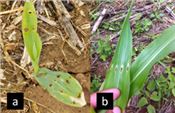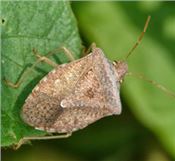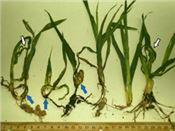|
Damage By Stink Bugs Observed In Seedling Corn
DR. RAUL T. VILLANUEVA
PRINCETON, KY.
Seedling corn presenting feeding injures caused by stink bug have been observed in commercial and research plots in western Kentucky. In a small replicate corn field test where seedlings were not more than 7 days emerged showed more than 45 plants with elongated transversal holes in expanding corn leaves (Figures 1a and 1b). These holes run perpendicular to the length of the leaf and can be different sizes. Around the holes’ edges, leaves have a yellowish shade; this is a sign of damage by stink bugs. While plants continue growing, these holes will expand. Also, corn plants damaged by stink bugs may produce suckers (tillering) and present irregular growth (Figure 2), or be stunted.
All these changes are caused by the insertion of stink bug piercing and sucking (needlelike) mouthparts into stems, leaves, or apical meristems of corn plants. During this process, stink bugs inject enzymes into plants to aid digestion and fluid removal. Laboratory and field studies conducted at the University of Kentucky by the end of the 1980s showed that the brown stink bug (Euschistus servus) and the onespotted stink bug (E. variolarius) can reduce plant densities, cause stunted plants with reduced root systems, result in suckers, and cause these plants to yield small or no ears.
Stink Bugs
Stink bugs include several species of Hemipteran insects that receive their name from the ‘unpleasant’ smell they produce when they are disturbed. Stink bugs causing damage in corn belong to the Pentatomidae family. Stink bugs affect field crops, vegetables, fruit, and ornamentals. Attacks to corn were first reported around the 1980s, and their occurrence in corn has been increasing since that time. Stink bugs causing the damage described above are most certainly the brown stink bug and the onespotted stink bug. Both are native to Kentucky and overwinter in non-tilled corn or wheat fields. Little is known about the impact or management of this insect on corn seedlings.
In recent years, there have been at least three well known cases of invasive stink bug species that are expanding their geographic range in the USA (the brown marmorated stink bug (Figure 3), the red banded stink bug, and the bagrada bug). Only the brown marmorated stink bug is found in some areas of Kentucky. In Kentucky, pest stink bugs are often connected with soybean, tobacco, tree fruit, and tomatoes, small grains, and is becoming an increasing problem in sweet corn.
Management
This early occurrence of stink bugs in corn coincides with information from previous studies that suggested wheat could be an early spring host for these insects that move to corn fields when corn emerges. The abundances in corn may be related to the presences of stink bugs in soybeans near the harvest time in this field and many areas of central and western Kentucky in 2018. While conducting aphid tallies in research wheat plots, I found that brown stink bug has been present a little earlier this year.
Management actions to control stink bugs at earlier stages of corn development have not completely studied. However, scouting for pests that affect earlier stages of corn, such as cutworms, apple maggot, or slugs, is an effective and preventive way to manage damage caused by stink bugs. In the publication Insecticide Recommendations for Field Corn-2019, the insecticides recommended for cutworm “rescue treatments” might be used if a problem with stink bugs is found. ∆
DR. RAUL T. VILLANUEVA: Extension Entomologist, University of Kentucky

Elongated transversal holes in (a) seedling corn leaves, and (b) more mature leaves.
Photo: Raul Villanueva, UK

Brown stink bug
Photo: Doug Johnson, UK

Seedling corn with suckers (three plants in the right, blue arrows), and irregular growth of
plants (white arrow) caused by feeding of stink bugs.
Photo: Raul Villanueva, UK
|
|